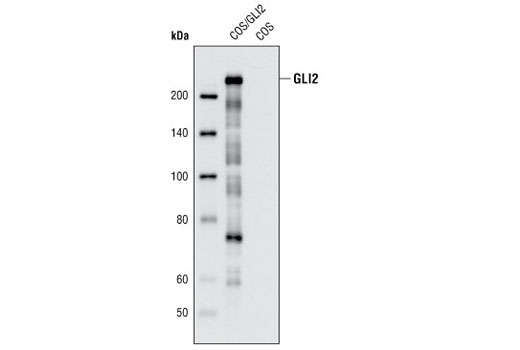WB
H
Transfected Only
220
Rabbit
#P10070
2736
Product Information
Product Usage Information
| Application | Dilution |
|---|---|
| Western Blotting | 1:1000 |
Storage
Specificity / Sensitivity
Species Reactivity:
Human
Source / Purification
Polyclonal antibodies are produced by immunizing animals with a synthetic peptide corresponding to residues surrounding Arg770 of human GLI2. Antibodies are purified by peptide affinity chromatography.
Background
GLI was first identified as a gene amplified in a malignant glioma (1) capable of transforming primary cells in cooperation with adenovirus E1A (2). GLI belongs to the Krüppel family of zinc finger proteins that includes three mammalian GLI proteins: GLI1, GLI2, and GLI3 (3). These GLI proteins are similar to the Drosophila homolog Cubitus interruptus (Ci) and function as transcription factors activated by the Hedgehog signaling pathway. Hedgehog signaling plays an important role in animal development, and research studies have shown that this pathway is aberrantly activated in many types of cancers (4,5).
GLI2 contains both transcription repression and activation domains (6) and several isoforms of GLI2 have been reported that may have different activities (7-9). Overexpression of GLI2 in skin causes basal cell carcinoma in mice (10), while loss-of-function of GLI2 is associated with pituitary anomalies (11).
- Kinzler, K.W. et al. (1987) Science 236, 70-3.
- Ruppert, J.M. et al. (1991) Mol Cell Biol 11, 1724-8.
- Kinzler, K.W. et al. (1988) Nature 332, 371-4.
- Ingham, P.W. and McMahon, A.P. (2001) Genes Dev 15, 3059-87.
- McMahon, A.P. et al. (2003) Curr Top Dev Biol 53, 1-114.
- Sasaki, H. et al. (1999) Development 126, 3915-24.
- Tanimura, A. et al. (1998) J Virol 72, 3958-64.
- Tojo, M. et al. (2003) Br J Dermatol 148, 892-7.
- Speek, M. et al. (2006) BMC Mol Biol 7, 13.
- Grachtchouk, M. et al. (2000) Nat Genet 24, 216-7.
- Roessler, E. et al. (2003) Proc Natl Acad Sci USA 100, 13424-9.
Species Reactivity
Species reactivity is determined by testing in at least one approved application (e.g., western blot).
Western Blot Buffer
IMPORTANT: For western blots, incubate membrane with diluted primary antibody in 5% w/v BSA, 1X TBS, 0.1% Tween® 20 at 4°C with gentle shaking, overnight.
Applications Key
WB: Western Blotting
Cross-Reactivity Key
H: human M: mouse R: rat Hm: hamster Mk: monkey Vir: virus Mi: mink C: chicken Dm: D. melanogaster X: Xenopus Z: zebrafish B: bovine Dg: dog Pg: pig Sc: S. cerevisiae Ce: C. elegans Hr: horse GP: Guinea Pig Rab: rabbit All: all species expected
Trademarks and Patents
Limited Uses
Except as otherwise expressly agreed in a writing signed by a legally authorized representative of CST, the following terms apply to Products provided by CST, its affiliates or its distributors. Any Customer's terms and conditions that are in addition to, or different from, those contained herein, unless separately accepted in writing by a legally authorized representative of CST, are rejected and are of no force or effect.
Products are labeled with For Research Use Only or a similar labeling statement and have not been approved, cleared, or licensed by the FDA or other regulatory foreign or domestic entity, for any purpose. Customer shall not use any Product for any diagnostic or therapeutic purpose, or otherwise in any manner that conflicts with its labeling statement. Products sold or licensed by CST are provided for Customer as the end-user and solely for research and development uses. Any use of Product for diagnostic, prophylactic or therapeutic purposes, or any purchase of Product for resale (alone or as a component) or other commercial purpose, requires a separate license from CST. Customer shall (a) not sell, license, loan, donate or otherwise transfer or make available any Product to any third party, whether alone or in combination with other materials, or use the Products to manufacture any commercial products, (b) not copy, modify, reverse engineer, decompile, disassemble or otherwise attempt to discover the underlying structure or technology of the Products, or use the Products for the purpose of developing any products or services that would compete with CST products or services, (c) not alter or remove from the Products any trademarks, trade names, logos, patent or copyright notices or markings, (d) use the Products solely in accordance with CST Product Terms of Sale and any applicable documentation, and (e) comply with any license, terms of service or similar agreement with respect to any third party products or services used by Customer in connection with the Products.
